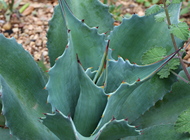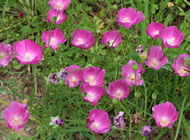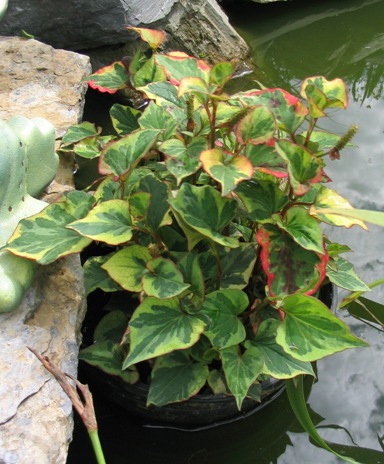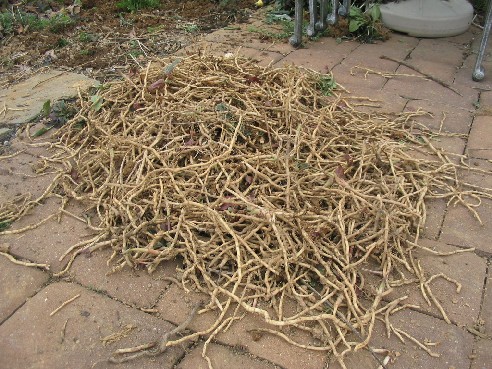 |
Houttuynia cordata |
 |
| Common name |
chameleon plant |
| Family |
saururaceae |
| Life cycle |
perennial |
| Flowers |
white |
| Size |
1 ft |
| Light |
sun-part shade |
| Cultural notes |
ordinary garden soil |
|
|
|
| Multicolored pink/burgundy/green foliage. Real pretty, but wants to run by roots in good garden soil - the photo at left shows the pile of roots we gathered from a smallish garden area, after allowing chameleon plant to roam freely for a few years (we're still battling the plants sprouting from roots we missed). It doesn't mind wet roots, so it can be used as pond marginal plant, but for us it hasn't proven winter-hardy that way.
|
We left this plant behind in our Pennsylvania garden (and wish it well); we don't grow it in Houston. About my plant portraits
PlantLinks to other web pages about Houttuynia cordata
Visitors to this page have left the following comments| Richard | Feb 01, 2005 | Please advise me. If I was to place a plant border underground around the chameleon planting bed, would that keep it in bounds or can it leap over a border like Enlish Ivy does? Thanks, Richard... Please email ga_seagull@yahoo.com |
| david mucklow | Jun 24, 2009 | Are there any herbicides that will kill this plant; I'm afraid my wife has created an ecological disaster at my house; how can this be controlled. mucklow1000@att.net |
| Moniquqe Larocque | Jul 08, 2009 | I am having a miserable time digging in my garden beds that I have worked so hard over many years until I purchase the chameleon plant. I'm been putting many hours in the past three weeks trying to get rid of the roots. I read many blogs and it seems that there is no solution to the problem. The roots are so deep and my biggest fear is my neighbours flower beds. moniquelarocque16@yahoo.com Thank you
The garden bed where mine were planted still sends up some chameleon plant shoots - but since I pull them out whenever I see them, they don't have nearly the energy they used to have; it's not too much work anymore to keep them contained. |
| Barbara | Aug 15, 2011 | I have a couple of trees that I'd like to plant something under because it is too hard to mow there. Would this do well under an oak tree, which I'm told has more acidic soil?
I'm not aware of the soil preferences of houttuynia, nor whether it would thrive in dry shade (it certainly enjoys wet - we only grow it as a potted pond plant any more). |
| Geri | Sep 04, 2011 | I planted some chameleon plants last year. They came up beautifully this year flowering, great color and then out of control!!!! I spent hours today getting rid of as much as I can. It was a big mistake planting this baby. I never knew it was so invasive. They don't tell you these things through mail order nurseries. I learned to totally research my plants from now on before selecting. Thanks Rob for your help lately:) |
| leigh | Sep 30, 2011 | those roots are edible! used in stirfry |
| Linda | Apr 28, 2015 | This plant is so invasive!!! I planted it in the front bed and it is now around the other side of my house and has come up all the way in the back bed. Now after 3 or 4 years it's everywhere. I have tried weed killer & digging up roots. We have dug up roots over 3 ft. deep in the ground! Any sure way to kill this stuff??
Just keep digging... |
| Elizabeth | Jul 12, 2020 | How to eradicate houttuynia cordata (chameleon plant)
What I did when Houttuynia cordata took over my garden beds. I was one of those unsuspecting persons who thought this was a lovely groundcover and brought a couple home. For a couple of years due to my job, I did not have much time as I would have liked to tend my garden. I did not know what this plant was going to do. When it was in bloom, the little white flowers seemed to add a sparkle to my landscaping. And then it happened. The penalty I paid for admiring this plant and letting it spread was that my beds ended up completely smothered and taken over by this plant. In my yard, the chameleon plant behaved like fairy sized kudzu. In July 2019 I began researching online and was thrown into a panic. The prospects did not look good for getting rid of it. I found out this plant is on the list of globally invasive problem plants. I was stressed. I am going to tell you what I did after reading everything I could uncover on the internet about trying to get rid of this plant.
I have never knowingly put any chemicals in my yard. I do not like them and I do not want to harm any wildlife or the ecosystem. However, in this instance, seeing how aggressive this plant was and having read that it can even spread under a driveway, I made a personal decision to use Ortho Poison Ivy Spray. It was not a decision made lightly. I did not want this plant taking over anymore of my property, spreading to my neighbors’ yards, or escaping into the wild areas where I live.
From July to early September, I carefully applied the spray. The container it comes in has a very narrow stream, so I was able to be careful and not lose any plants I didn’t want to. After this application during the hottest months in Memphis, TN, the offending plant began to look dead. But from my research I knew it is a zombie that would return come Spring. My next step was sheet mulching. My beds needed to be re-done anyway, so in my case, I just dug up plants that I absolutely needed to save and moved them and with a few – like my Baptisia that have long taproots and can’t be transplanted, I worked around.
1. In September my partner and I got a lot of cardboard. My source was behind stores like TJ Maxx. After they unpack clothing etc….they put all of the cardboard behind the retail establishments. The cardboard was clean. I removed any tape. I had purchased a large supply of landscape pins. I used the sheet mulching method. Heavy layer of cardboard, then wet it and had humus and triple milled hardwood mulch delivered and applied on top of the cardboard. The beds stayed like this until March when I began putting in new plants and shrubs.
2. Spring 2020. A silver lining to Covid Times, I worked from home through the Spring. This enabled me (with the help of my partner) to re-do my front garden beds and tend them everyday. After planting all of my new plants and shrubs and mulching with pine straw I checked every morning for any reappearing houttuynia leaves. Whenever one sprouts up, I zap it with poison Ivy spray. Yes, there have been a few that have popped up. I still do not like using poison. I am still getting rid of the plant, but honestly, so far the reemergence has been very easy to handle. Mostly because I have checked it everyday. I know I will have to keep on this, but I feel like I have it under control. I just hope I can continue to be vigilant next Spring when I will be at work. Meanwhile, my new landscaping is settling in. I planted a lot of natives, and my garden is humming with pollinators. Don’t give up.
|
I welcome comments about my web pages; feel free to use the form below to
leave feedback about this particular page. For the benefit of other visitors
to these pages, I will list any relevant comments you leave, and if
appropriate, I will update my page to correct mis-information. Faced with an
ever-increasing onslaught of spam, I'm forced to discard any comments including
html markups. Please submit your comment as plain text. If you have a
comment about the website as a whole, please leave it in my
guestbook. If you
have a question that needs a personal response, please
e-mail me.
Last modified:
June 20, 2004
Contact me
|



